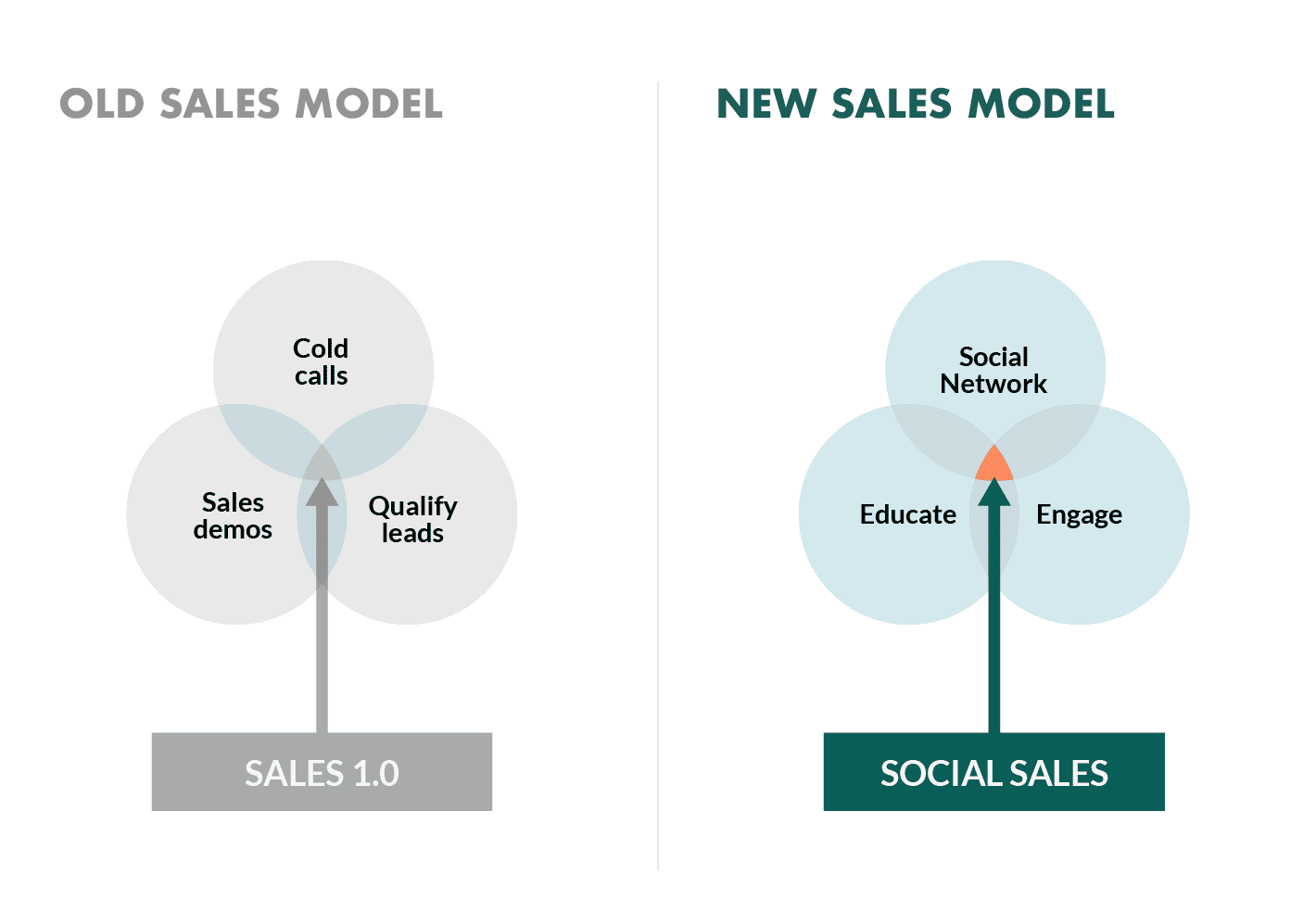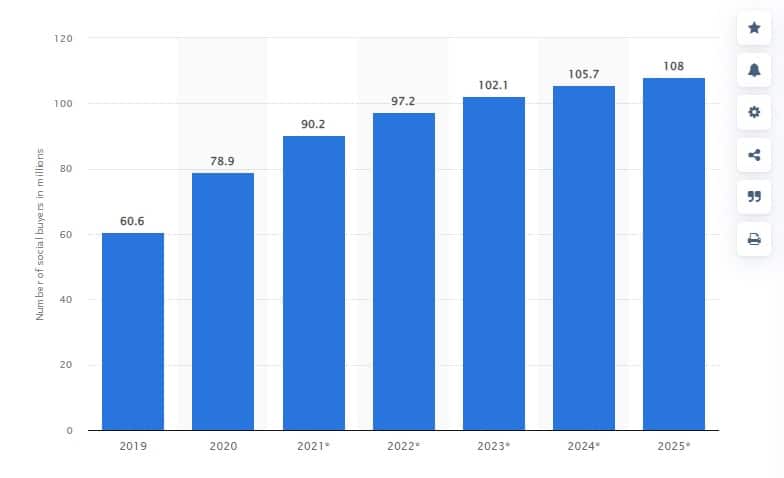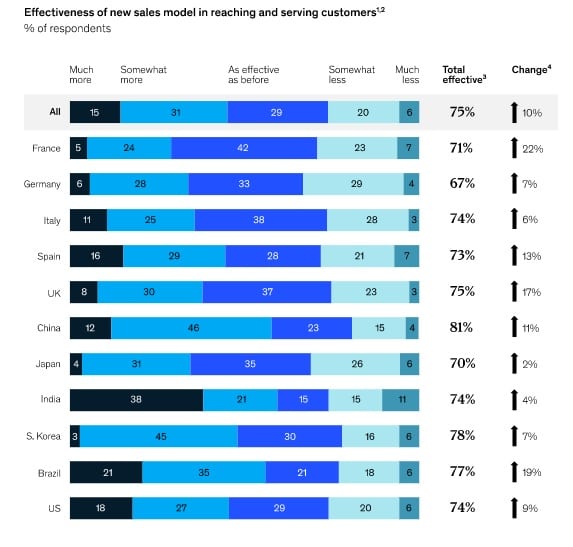
The Ultimate Guide to Effective Social Selling
Do you want to incorporate social selling into your sales strategy? We’ve got good news for you: you’ve probably already started.
If your company has a basic Facebook, LinkedIn, or Twitter page (or an account on any other social platform) then you’re doing some form of social selling.
The thing is, good social selling — the kind that brings in consistent, revenue-driving results — is like an art. It takes time, effort, planning, and follow through.
That’s why we’ve put together this guide to help you do social selling the right way. We’re going to cover:
- The basics of social selling (what you absolutely need to know)
- Why your company should be social selling
- How to figure out which social networks are right for your company
- 4 key principles of effective social selling
- Actionable tactics for executing your social selling strategy
- Tools that can help you get more ROI from your efforts
Let’s get started!
Quick Takeaways
- Social selling is taking the place of outdated sales tactics like cold calls.
- Between 70-80% of B2B decision makers and 78% of B2B professionals feel that new digital sales models — including social selling — are effective and/or preferred.
- Social selling requires targeted, personalized outreach rather than high-volume cold messaging.
- Companies should choose the social platforms that best align with their brand, content, and audience.
- Social selling technology tools provide key data insights and help sales reps scale their efforts.
Social Selling 101: The Basics
What is social selling?
Social selling is the practice of leveraging social networks to find, research, and build relationships with prospects and customers. It’s a lead generation technique used by sales teams to cultivate connections, increase conversions and sales, and improve retention.
When you hear the term social selling, you might think of sites like LinkedIn or even Facebook. But social selling is happening on every platform, including Twitter, Instagram, YouTube, and the newest leader of the social media pack — TikTok.
Social selling is taking the place of old sales techniques that have long been becoming outdated as technology advanced and communication norms changed. Strategies like cold calling or in-person demos are pretty much becoming things of the past. Today, all of that can happen online in a much more convenient and engaging way.

This new social sales model requires a different approach than the ones sales reps used in the past, and we’ll get into them in more detail later on in this article.
What is social selling not?
Social selling is often confused with two other social media-related strategies: social media marketing and social media advertising. While all of these are centered around social platforms, they’re really quite different. Let’s outline the definitions for all three to see how.
- As we know, social selling is the practice of using social platforms to build prospect and customer relationships.
- Social media marketing is using social media to promote a brand, product, or service.
- Social media advertising is placing paid ad campaigns on social media to increase brand reach and visibility.
The most important way that social selling differs from the other two strategies is that it focuses on individual relationships, not broad promotion. While both social media marketing and social media advertising can be great lead-up strategies for social selling, they are not the same thing.
Many brands have mastered both the marketing and advertising pieces, but if they aren’t following up with strong social selling, they’re missing out on huge opportunities to generate new leads and bring in more revenue.
Why should your company be doing social selling?
Your customers are engaged in social buying
Social buying occurs when consumers engage in commerce directly on social media platforms. It’s happening in both the B2B and B2C sectors, and has seen rapid growth over the past few years. According to Statista, social buying jumped 30% between 2019 and 2020 and is expected to continue its upward trajectory for the foreseeable future.

Consumers indicate that they aren’t just making purchases on social media, either. According to a recent study done by Sprout Social, more than a third of social media users are using it to conduct brand research, and 78% are more likely to choose a particular brand over a competitor after having a positive experience with them on social media.
These are hard numbers to ignore! As you can see, if you aren’t social selling, you’re leaving sales on the table for your competitors to grab.
Networking has gone digital
The pandemic has made digital interaction the norm. Where sales reps once found prospects at trade shows, conferences, and industry events, today they must find ways to make those same connections through digital channels. This massive shift to online relationship building has made social selling a necessity.
Especially because today’s digital sales model is likely not going away. A McKinsey study on the pandemic’s impact on B2B sales found that between 70-80% of B2B decision makers prefer the new model of remote human interaction and digital self-service, citing convenience, travel cost savings, and safety as three primary benefits.
To boot, 75% of B2B professionals from companies around the world say that this new model is effective for reaching and serving customers.

The takeaway: if you’re still waiting for the old sales model to return post-pandemic, you’re likely already being left behind.
Your competitors are already social selling
From established corporate enterprises to innovative new startups, brands are leveraging social selling strategies in droves. And guess what? They’re beating out the competition.
- 70% of sales professionals across industries are using social selling to generate leads
- 78% of salespeople using social selling techniques are outselling their competitors.
- Companies with formalized social selling strategies are 40% more likely to hit revenue goals
Social selling is no longer a trendy new strategy — it’s a competitive imperative.
Which networks are right for your company?
Now that we’ve covered the basics of social selling and why it’s so important, let’s dive into how to choose the right social networks for your business. Most companies actively use multiple social media platforms, and the right ones to choose depend on your company, industry, and customer base.
Twitter and Instagram, for example, are great for casual and punchy interactions with short posts and conversations in the comments section. LinkedIn is better suited for more formal or “professional” content. Facebook can do both, depending on how you use it.
Think about what makes the most sense for interacting with your customers, but remember you don’t have to be stuck in a box, either. There are enterprise B2B companies on TikTok and B2C brands succeeding on LinkedIn.
It’s all about aligning with your brand personality, the type of content you want to share, and the ways you want to communicate with your audience. Experiment with different platforms and stick with the ones working best for your company.
Most of all, don’t feel like you have to do everything on every platform. You might have a presence on many platforms but stick with one or two for social selling — and that’s okay! It’s better to execute really well on less platforms than stretch your sales team too thin trying to operate on all of them.
4 key principles of effective social selling
Build a professional brand
The brand you build on social media is representative of your entire company. To set yourself up for success with social selling, pay attention to the details of your brand’s online presence. Use your platforms to demonstrate that you are a trustworthy, professional brand. Some easy ways to do this are:
- Use high-quality, on-brand images
- Make your “about” information and company profile complete and accurate
- Be professional in all interactions
- Be aware of the sources for content you share from other profiles
Target the right prospects
Social selling is not about casting the widest net possible. In fact, when you reach out to prospects that aren’t a good fit for your solutions, your communications come off as spammy and your sales reps end up wasting a lot of time.
Use social selling tools and techniques (more on these in the next section) to identify the right prospects to target. When you do, you’ll make more meaningful connections and have more success converting prospects into paying customers.
Be authentic
Your social media presence is an extension of your overall brand. As such, the tone, voice, communication style, and content you use on social media should align with that brand. This is one reason good collaboration between sales and marketing teams is so beneficial. Your marketing team can set the guidelines and be a resource for staying on-brand, while your sales team uses that guidance to build authentic, meaningful relationships with prospects.
Stay informed by data-driven insights
Social media platforms have tons of built-in tools you can use to measure the success of your social selling efforts. You can also use separate tools (which we’ll cover next) to keep your strategy metrics-driven. The key is to make data a consistent, frequent part of your strategy so that you know what’s working and when you need to adjust your approach.
Here are some key social selling metrics you should be tracking:
- LinkedIn Social Selling Index (SSI) Score – If you’re using LinkedIn, you definitely want to use their SSI. It measures your social selling score using four elements: professional brand, engagement with the right people, insightful content, and relationship building. It also helps you find ways to improve in each area when needed.
- Content Engagement – How much value are you adding to your community with your content? Are you establishing yourself as an expert in your industry? Measuring content engagement indicators such as likes, comments, and shares gives you insight into the content your audience finds most engaging and helps you refine your strategy accordingly.
- Click Through Rate (CTR) – Ultimately, you want your content and social selling outreach to drive prospects toward action. This typically involves clicking through to the next step, whether it’s your website, an inquiry form, a download, or something else. Tracking your CTR tells you how effective your efforts are at generating real interest.
- Conversations Started – It’s true that social selling prioritizes quality over quantity for the most part. However, tracking the number of conversations started by your sales reps can hold your team accountable and keep them motivated. After all, as long as you’re targeting the right leads and maintaining quality standards, more conversations will lead to more conversions.
Executing your social selling strategy
Build your profile and presence
Even after you’ve covered the basics of establishing a professional brand image on social media, it takes time to build a true presence. This is one of the most critical components of social selling success, as every prospect you interact with will likely check your profile for credibility. You can build your presence by consistently producing and sharing valuable content, adding insightful commentary to conversations within your industry, and engaging with comments on your posts and others.
Here are some helpful tips from marketing and sales guru Neil Patel for establishing your social presence and personal brand:
Monitor conversations about your company and industry
Social media monitoring is the continual tracking of online conversations about your brand, industry, and competitors. It’s beneficial for a few reasons.
First, it gives you insight into what prospects and customers think about your brand. People are honest on social media. Paying attention to what they’re saying in posts, comments, and reviews can help you understand what’s working in your customer relationships and where you need to improve. It also helps you identify and address problems earlier. Second, it keeps you in the know about important conversations and events related to your competitors and your larger industry.
All of these insights can help you build a social selling strategy that’s timely, relevant, and directly addresses customer needs.
Find your prospects
As you build your social media presence and track conversations, you will naturally start to identify prospects within your online community. You can also search for them directly by using search filters or looking through hashtags and brand mentions. It’s critical that you stay organized when finding and managing your prospects to ensure your outreach is intentional and personalized. Using a good CRM system or a well-built Google Sheet are two ways to do it.
Make your outreach
As I’m sure you can see by now, social selling outreach is not cold messaging. So, let’s start with what not to do: do not just pull up your prospect list and send them all the same salesy direct message. When it comes to quality social selling, your outreach should happen organically and always feel authentic.
This usually means starting with less direct interactions, such as following a prospect’s profile, liking or sharing their content, or interacting in a comments section. Once you feel that you’ve established a connection and know enough about their pain points, it’s time to make a more direct outreach — like through a direct message. But even your messages should not start with a hard sell. Introduce yourself, show that you’ve done your homework, and take time to build the relationship first.
Be responsive to inquiries
As your following grows and you continue to share valuable content with your audience, you will earn your own warm leads and receive direct inquiries from prospects. Establish specific times for checking and managing these inquiries. Always respond to every inquiry. Ideally, you should always answer inquiries within 24 business hours.
Stay consistent
Building a strong social media presence and growing your following takes time. It also requires consistent effort. Plan ahead and be sure your posting activity doesn’t ebb and flow — it should remain active and never experience long gaps when there is no content shared.
The same goes for engaging with other content and starting new conversations. Be consistent with your efforts. Set and stick to a schedule, blocking out time during your workday specifically for social selling.
Use social selling tools
Social selling tools help you stay organized, be data-driven, and scale your efforts. There are lots of great options on the market, and the right one for you will depend on the platforms you’re using and the tactics you’re leveraging to execute your strategy. Let’s take a look at some of the most popular tools used by sales reps today.
- LinkedIn Sales Navigator – One of the most-used B2B social selling tools. It helps users find and target the right prospects, provides alerts on prospects’ company or job updates, enables lead tracking, and integrates well with other CRM systems.
- Hootsuite – Effective for managing content across multiple platforms and using social listening to track conversations about your company, industry, and competitors.
- EveryoneSocial – Like Hootsuite, this tool helps you manage content effectively across platforms and leverage social listening. It also has more social selling-specific features like sales-focused analytics and collaboration options for sales teams.
- ZoomInfo ReachOut – Plugin that integrates with LinkedIn to provide direct contact information like email and phone number for prospects you connect with on the platform.
- HubSpot – Popular CRM tool for tracking leads across all channels. Can enhance social selling with its funnel-focused insights that tell you where a lead was sourced and where they are on the buyer journey.
While none of these tools can do the work for you — your social selling efforts should always be human-centered and authentic — these tools can enhance your strategy with data insights and advanced technologies.
Boost your social selling strategy with great content
Great content relevant to your industry establishes your company as a thought leader and provides direct value to your audience — including sales prospects. The team of writers and SEO experts at Marketing Insider Group can deliver you optimized, ready-to-publish content every week for one year (or more!).
Check out our SEO Blog Writing Service for more information, or schedule a quick consultation to get started!


![Use the Tidal Wave Technique to Increase Blog Traffic [Ultimate Guide]](https://marketinginsidergroup.com/wp-content/uploads/2020/06/increase-blog-traffic0.png)



